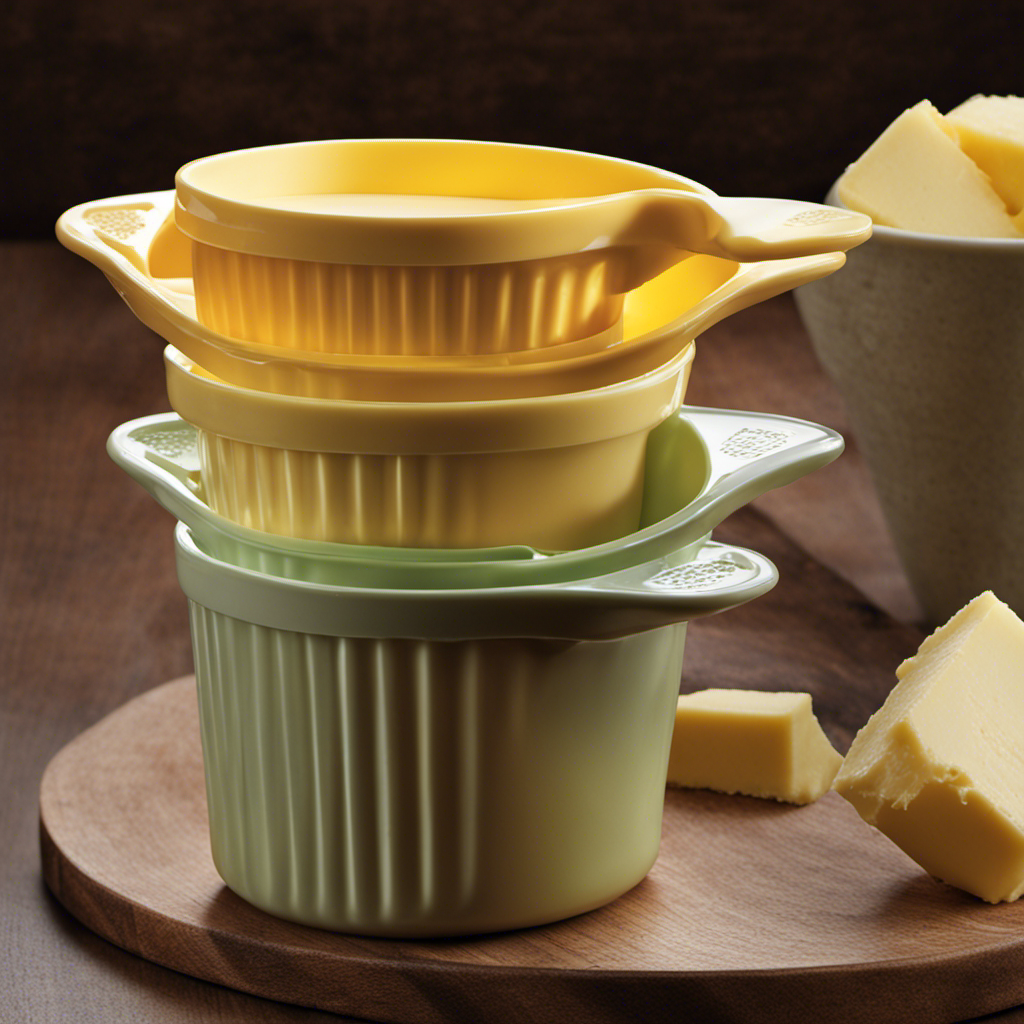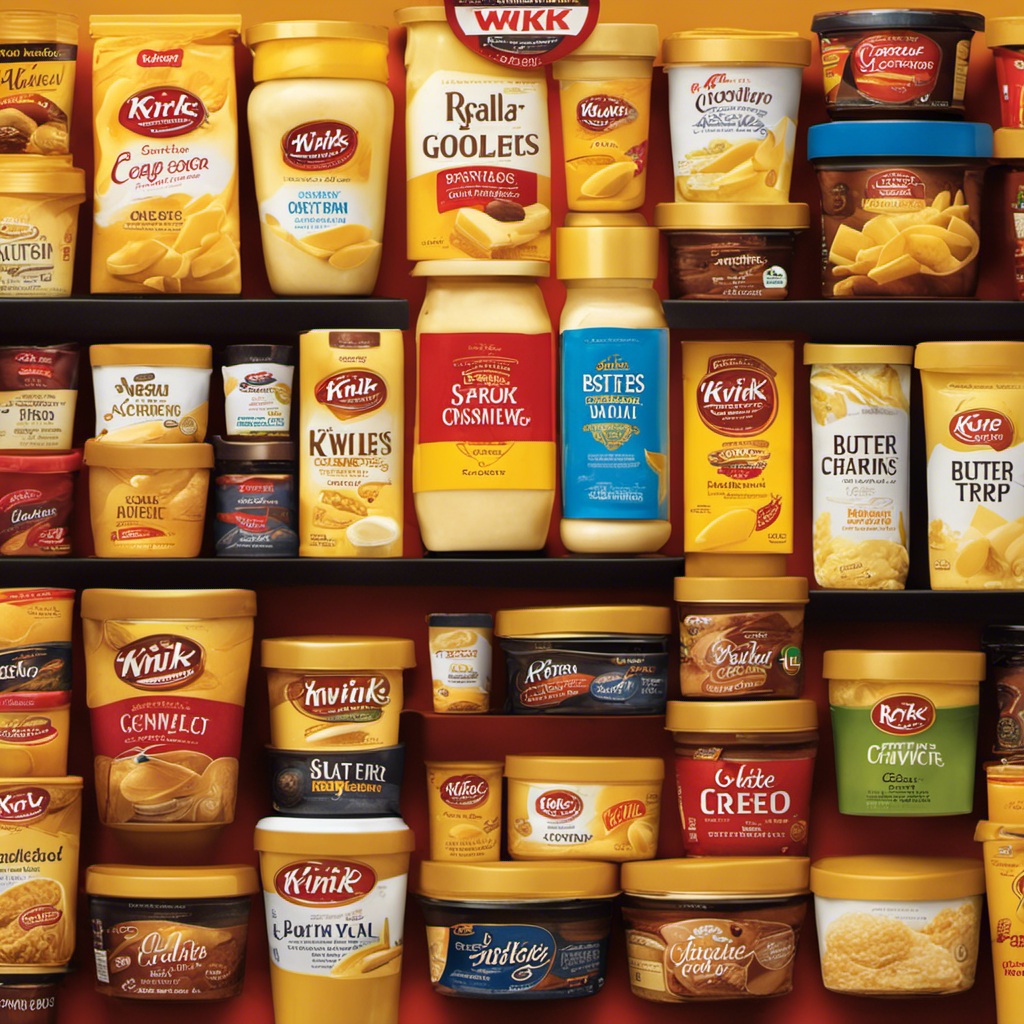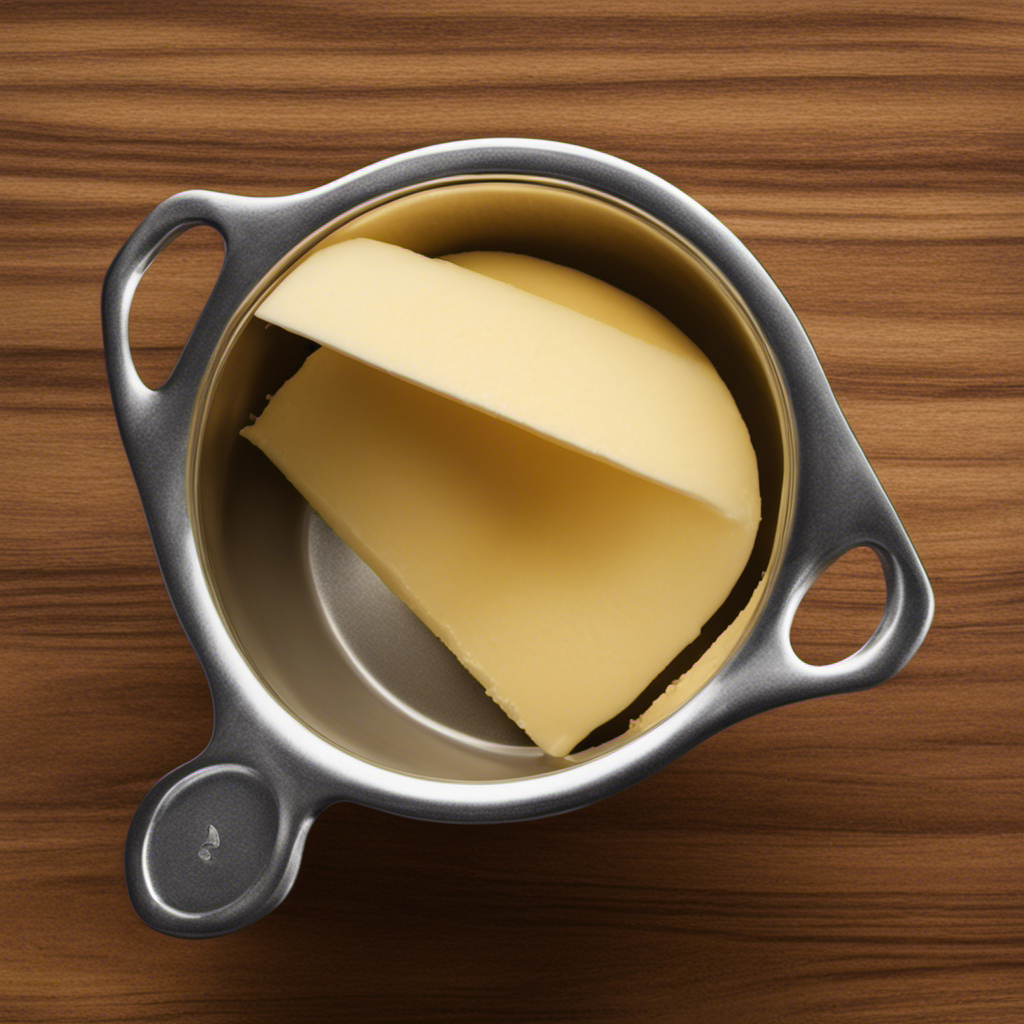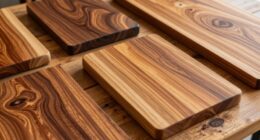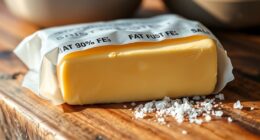As someone who bakes at home, I frequently encounter challenges with measuring butter. It’s exasperating trying to determine the cup equivalent of a single stick of butter.
But fear not, fellow bakers! In this article, I’ll unravel the mystery and provide you with all the answers you need.
So grab your apron and get ready to bake with confidence, as we delve into the world of butter measurements.
Key Takeaways
- One stick of butter is equal to 1/2 cup or 8 tablespoons.
- A standard stick of butter weighs 4 ounces or 113 grams.
- Butter is often measured in sticks, cups, tablespoons, or grams, depending on the recipe.
- Accurate measurements are crucial for baking.
Understanding the Measurements
To understand the measurements, you’ll need to know how many cups one stick of butter is. A stick of butter is equivalent to 1/2 cup or 8 tablespoons. This measurement is widely used in American recipes.
It is important to note that butter sticks in other countries may have different measurements. So, if you are using a recipe from a different country, it’s crucial to double-check the measurements.
When measuring butter, it’s best to use a kitchen scale or the measurement lines on the butter wrapper. This ensures accuracy and consistency in your recipes.
Understanding these butter measurement equivalents will help you achieve the desired results in your culinary endeavors.
Butter Stick Vs Cup Ratio
When it comes to baking, one of the most common sources of confusion is the conversion of butter measurements. In this discussion, I will clarify this conversion and make butter measurement easy for you.
We will explore the ratio between butter sticks and cups, helping you decide whether to use a stick or a cup of butter for your recipe.
Conversion Confusion Clarified
There’s a lot of confusion about how many cups one stick of butter equals. Let me clear up the confusion and provide some butter measurement tips to avoid common butter measurement mistakes.
Here are five key points to consider:
- One stick of butter is equal to 1/2 cup or 8 tablespoons.
- It’s important to measure butter correctly for accurate baking results.
- Softened butter should be measured by pressing it firmly into a measuring cup.
- For recipes that require melted butter, measure it after melting, not before.
- If you don’t have a measuring cup, you can use the wrapper of a butter stick as a handy guide.
Understanding these butter measurement tips and avoiding common mistakes will make your baking experiences much easier.
Now, let’s dive into how to make butter measurement even easier.
Butter Measurement Made Easy
Measure your softened butter by pressing it firmly into a measuring cup. This simple hack ensures an accurate measurement every time.
But what if you don’t have a measuring cup? Don’t worry, there are tricks for measuring butter without one.
One stick of butter is equivalent to 1/2 cup or 8 tablespoons. So if your recipe calls for 1 cup of butter, you can easily measure out 2 sticks or 16 tablespoons.
Another handy trick is to use the markings on the butter wrapper itself. Most butter sticks have tablespoon markings printed on the wrapper, making it easy to measure out the desired amount.
Stick or Cup?
If you’re unsure about how to measure butter, you can easily convert between sticks and cups using the helpful equivalencies provided. When it comes to measuring butter, it’s important to have accurate conversions at your fingertips. Here are some handy conversion methods and butter storage tips to keep in mind:
- 1 stick of butter is equal to 1/2 cup or 8 tablespoons.
- 1 cup of butter is equivalent to 2 sticks or 16 tablespoons.
To convert from cups to sticks, divide the number of cups by 2. To convert from sticks to cups, multiply the number of sticks by 2. When storing butter, keep it tightly wrapped in its original packaging or in an airtight container to prevent it from absorbing unwanted odors.
With these conversion methods and butter storage tips, you’ll have no trouble measuring and storing butter for all your cooking and baking needs.
Converting Butter Measurements
When it comes to baking, accurate measurements are crucial for perfect results. One common question that often arises is the conversion ratio between cups and sticks of butter. Understanding this ratio is essential for ensuring that your recipes turn out just right.
In this discussion, we will explore the butter conversion ratios, specifically focusing on the cup to stick conversion and other butter measurement equivalents.
Butter Conversion Ratios
To convert butter measurements, one stick is equal to 1/2 cup. When it comes to butter measurement tips, here are some important things to keep in mind:
-
Always check the recipe: Make sure you carefully read the recipe to determine the required amount of butter.
-
Use a measuring cup: To accurately measure butter, use a measuring cup specifically designed for liquids. This will ensure precise measurements.
-
Soften butter properly: If a recipe calls for softened butter, make sure it is at room temperature before using. This will ensure proper incorporation into the recipe.
-
Consider the conversion: If you’re converting a recipe that uses cups to sticks, remember that 1 cup is equal to 2 sticks of butter.
-
Adjust for different quantities: If the recipe requires a different amount of butter than what you have on hand, use simple math to adjust the measurements accordingly.
Understanding these butter measurement tips will help you confidently convert butter in your recipes. Now, let’s dive into the next section about converting cups to sticks.
Cup to Stick
Converting measurements from cups to sticks can be a helpful technique in baking. When it comes to understanding conversions and converting butter for cooking, it is important to know how many cups are equivalent to one stick of butter.
In the United States, butter is typically sold in sticks, with each stick weighing 1/2 cup or 8 tablespoons. This means that if a recipe calls for 1 cup of butter, you would need to use 2 sticks. Similarly, if a recipe requires 2 cups of butter, you would need 4 sticks.
Understanding this conversion can make it easier to follow recipes and ensure accurate measurements.
Now, let’s delve into the butter measurement equivalents and explore other useful conversions.
Butter Measurement Equivalents
Understanding the equivalents for measuring butter can help you accurately follow recipes and ensure you have the right amount. Butter density can vary depending on factors such as temperature and brand. Converting butter in different recipes can be tricky, but it’s important to get it right to achieve the desired results.
Here are five key points to keep in mind when measuring butter:
- One stick of butter is equivalent to 1/2 cup or 8 tablespoons.
- If a recipe calls for melted butter, measure the solid butter before melting.
- To convert from grams to cups, divide the weight of butter by 227 (the weight of one cup).
- If a recipe calls for softened butter, leave it at room temperature until it is easily spreadable.
- When substituting margarine for butter, use a 1:1 ratio, but keep in mind that the flavor and texture may be slightly different.
Understanding these measurements and conversions will help you confidently navigate any recipe that calls for butter.
The Standard Stick of Butter
Did you know that one stick of butter is equal to 1/2 cup?
When it comes to baking and cooking, accurate measurements are crucial for a successful outcome. Understanding conversion tips and mastering measuring techniques can greatly improve your culinary skills.
To convert butter from sticks to cups, it’s important to know that a standard stick of butter weighs 4 ounces or 113 grams. This equals 1/2 cup or 8 tablespoons. If a recipe calls for 1 cup of butter, you will need 2 sticks. Similarly, if a recipe calls for 1/4 cup of butter, you can simply use half a stick.
How Many Cups in a Stick
In my previous subtopic, I discussed the standard stick of butter. Now, let’s delve into understanding conversions and common recipe measurements for butter.
When it comes to baking or cooking, it’s important to know how many cups are in one stick of butter. This knowledge allows us to accurately follow recipes and achieve the desired results. Here are a few key points to keep in mind:
- One stick of butter is equivalent to 1/2 cup or 8 tablespoons.
- If a recipe calls for 1 cup of butter, you will need 2 sticks.
- Half a stick of butter is equal to 1/4 cup or 4 tablespoons.
- For recipes requiring larger quantities, such as 2 cups of butter, you’ll need 4 sticks.
- Remember, it’s always a good idea to check the recipe for specific measurements.
Now that we understand the conversions and common measurements for butter, let’s move on to exploring butter measurements in recipes.
Butter Measurements in Recipes
Let’s take a closer look at how butter measurements are typically used in recipes. Understanding butter density and using accurate measurements is important to ensure the success of your recipe. Butter is often measured in sticks, cups, tablespoons, or grams, depending on the recipe. To give you a better idea, here’s a table that shows the different measurements for butter:
| Measurement | Equivalent |
|---|---|
| 1 stick | 1/2 cup |
| 1/2 stick | 1/4 cup |
| 1/4 stick | 2 tablespoons |
| 1 tablespoon | 1/8 stick |
| 1 pound | 4 sticks |
Cups to Sticks Conversion
When it comes to baking, understanding butter ratios is essential. One common question that arises is how to accurately convert butter measurements from cups to sticks. Let me break it down for you.
To convert cups to sticks of butter, keep in mind that one stick of butter is equal to 1/2 cup. So if a recipe calls for 1 cup of butter, you will need 2 sticks. Here are a few key points to remember:
- 1 stick of butter = 1/2 cup
- 2 sticks of butter = 1 cup
- 4 sticks of butter = 2 cups
- 8 sticks of butter = 4 cups
- 16 sticks of butter = 8 cups
By understanding these ratios, you can convert butter measurements accurately and ensure your baked goods turn out just right.
Happy baking!
Measuring Butter for Baking
Understanding how to accurately measure butter for baking is essential for successful results in your recipes.
One important aspect to consider is the consistency of the butter. It should be at room temperature for most baking recipes, which means it should be soft but not melted. This allows the butter to incorporate well with other ingredients and create a smooth texture. To achieve the perfect consistency, you can leave the butter out on the counter for about 30 minutes before starting your recipe.
Another tip for butter storage is to keep it in an airtight container in the refrigerator. This helps to maintain its freshness and prevent it from absorbing any strong odors.
Now that we have a good understanding of butter consistency and storage, let’s move on to a handy butter conversion cheat sheet.
Butter Conversion Cheat Sheet
When it comes to baking, understanding butter measurement equivalents and being able to convert butter quantities is essential.
It can be frustrating to find a recipe that calls for butter in grams when all you have is sticks of butter.
Luckily, with a handy butter conversion cheat sheet, you can easily navigate through different butter measurements and ensure your baked goods turn out perfectly every time.
In this discussion, I will provide a comprehensive guide on butter measurement equivalents and share tips on how to convert butter quantities effortlessly.
Butter Measurement Equivalents
To measure the amount of butter in cups, you can use the equivalent of one stick. Understanding butter density is crucial when converting butter for cooking. Here are some key points to consider:
- Butter is denser than water, so 1 cup of butter is not the same as 1 cup of water.
- A standard stick of butter weighs 4 ounces or 113 grams.
- One stick of butter is equivalent to 1/2 cup or 8 tablespoons.
If a recipe calls for 1 cup of butter, you will need 2 sticks. It is important to measure butter accurately as it can affect the texture and consistency of your baked goods.
Converting Butter Quantities
Remember, accurately measuring the amount of butter is essential for achieving the desired texture and consistency in your baked goods. Understanding butter measurements and converting butter quantities can be helpful in ensuring your recipes turn out just right.
When it comes to converting butter for cooking, it’s important to know that one stick of butter is equal to 1/2 cup or 8 tablespoons. This can be especially useful when a recipe calls for a specific amount of butter in cups, but you only have a stick of butter on hand.
Butter Equivalents in Cups
Butter in stick form is equivalent to 1/2 cup. When converting butter in baking recipes, it’s important to know the measurement equivalency. Here are some key points to keep in mind:
- 1 stick of butter = 1/2 cup
- 2 sticks of butter = 1 cup
- 1/4 cup of butter = half a stick
- 1/3 cup of butter = 5 and 1/3 tablespoons
- 1/2 cup of butter = 1 stick or 8 tablespoons
Understanding these equivalencies will help you accurately measure and convert butter in your recipes. Whether you need to halve a recipe, double it, or simply want to substitute butter with a different ingredient, knowing these conversions will ensure your baking turns out just right.
Adjusting Recipes for Butter
When it comes to baking, sometimes we run out of ingredients or want to make a healthier choice. That’s why it’s important to know about butter substitution options.
In this discussion, we’ll explore different alternatives to butter that can be used in recipes. Additionally, we’ll learn how to convert butter measurements accurately, so you can confidently adjust your recipes without any guesswork.
Butter Substitution Options
If you’re running low on butter, you can use alternatives like margarine or coconut oil as a substitution option. These options can provide a similar texture and flavor to your recipes. Here are some butter alternatives to consider:
- Margarine: A common substitute for butter, margarine is made from vegetable oils and has a similar consistency.
- Coconut oil: This plant-based oil can be a great substitute for butter in baking, especially in recipes that call for a tropical flavor.
- Olive oil: Another healthier alternative, olive oil can be used in cooking and baking to replace butter, providing a different taste profile.
- Avocado: Mashed avocado can be used in recipes that require butter, adding a creamy texture and some healthy fats.
- Nut butters: Peanut butter, almond butter, or cashew butter can be used to add flavor and richness to recipes instead of butter.
Now that you know about these butter alternatives, let’s move on to converting butter measurements.
Converting Butter Measurements
To convert the amount of butter needed in your recipe, you can use a simple ratio and substitute it with a different ingredient. Understanding conversions and having tips for precise measurements is essential in cooking. Here is a table to help you convert butter measurements:
| Butter Measurement | Equivalent Measurement |
|---|---|
| 1 stick | 1/2 cup |
| 1/2 stick | 1/4 cup |
| 1/4 stick | 2 tablespoons |
| 1/8 stick | 1 tablespoon |
| 1/16 stick | 1/2 tablespoon |
Using Butter Substitutes
You can use butter substitutes if you don’t have any regular butter on hand. There are several options available that can be used in baking and cooking. Here are some tips for using butter substitutes:
-
Vegetable oil: This is a common substitute for butter in baking recipes. Use the same amount of oil as you would butter, but be aware that it may change the texture and flavor of the final product.
-
Applesauce: Applesauce can be used as a substitute for butter in recipes that call for a moist and dense texture. Replace half of the butter with applesauce for best results.
-
Greek yogurt: Greek yogurt can add moisture and creaminess to baked goods. Use the same amount of yogurt as you would butter, but reduce the liquid in the recipe by 1/4 cup.
-
Avocado: Avocado can be used as a healthier alternative to butter. Mash a ripe avocado and use it as a 1:1 substitute for butter in recipes.
-
Coconut oil: Coconut oil is a popular dairy-free substitute for butter. Use the same amount of coconut oil as you would butter, but keep in mind that it may add a slight coconut flavor to your recipe.
Remember to experiment and adjust the measurements and ingredients based on your personal preferences and dietary needs. Happy baking!
Calculating Butter Volume
Calculating the volume of butter can be tricky, but there are conversion charts available to help you determine the amount needed for your recipe. Understanding butter density is key when converting butter measurements for cooking.
Butter is denser than water, which means it takes up less space for the same weight. In the United States, butter is typically sold in sticks, with each stick weighing 1/2 cup or 8 tablespoons. However, if you need to measure butter in different units, such as grams or ounces, it’s important to know the conversion factors.
For example, one stick of butter is approximately 113 grams or 4 ounces. These conversion charts can be a valuable tool in ensuring precision in butter measurements, which is crucial for achieving the perfect texture and flavor in your recipes.
Precision in Butter Measurements
Understanding the importance of precision in measuring butter is crucial for achieving the desired results in your recipes. When it comes to baking and cooking, even a small error in butter measurement can significantly affect the texture, flavor, and overall outcome of your dish.
Here are some common mistakes to avoid when measuring butter:
- Eyeballing: Guessing the amount of butter can lead to inconsistencies in your recipes.
- Using the wrong measuring tool: Using a cup instead of a scale can result in inaccurate measurements.
- Not softening butter properly: Softening butter to room temperature ensures accurate measurement.
- Forgetting to level off the butter: Excess or insufficient butter can throw off the balance in your recipe.
- Ignoring the markings on the wrapper: Many butter wrappers have measurements marked, making it easier to measure accurately.
Tips for Measuring Butter Accurately
When measuring butter, it’s important to soften it properly to ensure accurate measurements. Measuring butter without a scale can be tricky, but with a few tips, you can get it right every time.
One common mistake is not properly softening the butter. It should be soft enough to easily scoop but not melted or too warm.
Another mistake is not using the correct measuring tool. In the United States, butter is usually sold in sticks, with each stick being 1/2 cup or 8 tablespoons. So, if your recipe calls for 1 cup of butter, you would need 2 sticks.
It’s also important to remember that different countries may have different measurements for butter.
Frequently Asked Questions
Can I Use Margarine Instead of Butter in Recipes?
Yes, you can use margarine instead of butter in recipes. However, it’s important to consider health concerns as margarine may not be a healthier alternative. Additionally, using margarine may affect the taste of baked goods.
How Can I Accurately Measure Butter Without a Scale?
When measuring butter without a scale, I find it helpful to use the markings on the wrapper. One stick usually equals 1/2 cup. If you are looking for accurate measurements, it’s important to avoid using butter substitutes as they may have different measurements.
Are There Any Substitutes for Butter That Can Be Used in Baking?
There are several substitutes for butter in baking, such as applesauce, mashed bananas, or Greek yogurt. These alternatives can add moisture and flavor to your recipes, making them a tasty and healthier option.
How Do I Adjust a Recipe That Calls for Sticks of Butter to Use Cups Instead?
To adjust a recipe that calls for sticks of butter to use cups instead, I would first determine the conversion factor by measuring how many cups are in one stick. Then, I would simply multiply the number of sticks needed by the conversion factor to get the equivalent amount in cups.
Is There a Difference in Taste or Texture When Using Salted or Unsalted Butter in Recipes?
Using salted or unsalted butter can make a difference in flavor and impact the overall recipe. Salted butter adds a subtle savory taste, while unsalted allows you to control the saltiness. It’s all about personal preference and the specific dish you’re making.
Conclusion
In conclusion, knowing the measurement equivalents of butter can be incredibly helpful in the kitchen. Understanding that one stick of butter is equal to 1/2 cup can make recipes easier to follow and ensure accurate results.
For example, imagine you’re making a batch of chocolate chip cookies and the recipe calls for 1 cup of butter. Knowing that this is equivalent to 2 sticks of butter can save you from adding too much or too little and ensure your cookies turn out perfectly.
So, next time you’re baking, remember the importance of precise butter measurements!
